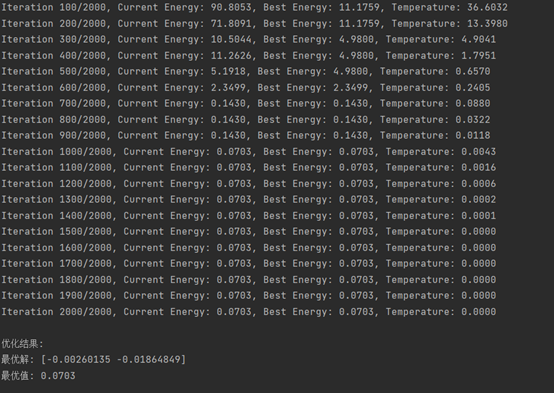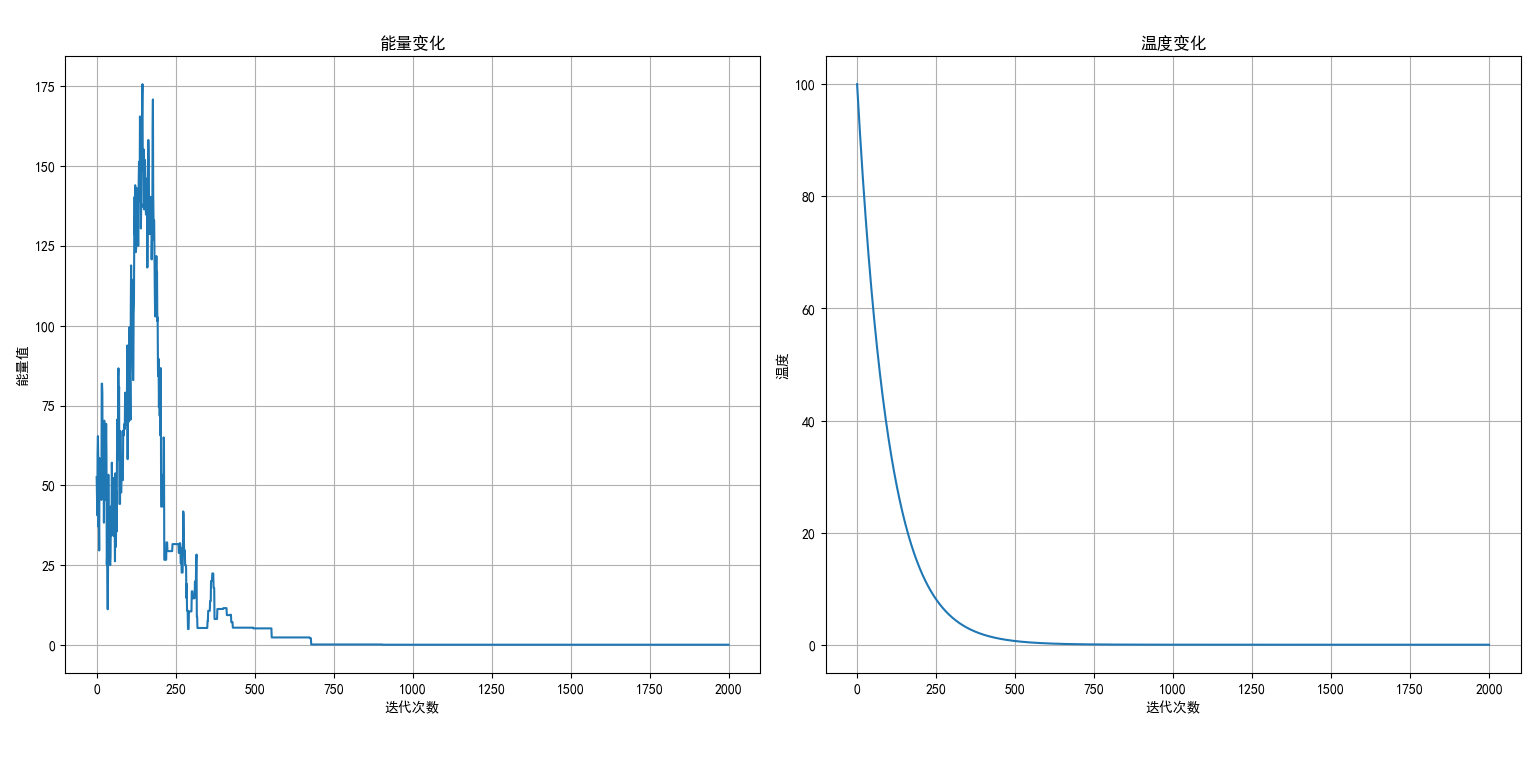模拟退火算法(Simulated Annealing, SA)是一种受物理中固体退火过程启发的元启发式优化算法,用于在大规模搜索空间中寻找近似全局最优解。其核心思想是通过模拟物理退火过程中的“温度”下降和粒子热运动,逐步收敛到低能量(即目标函数更优)的状态。
一、基本原理
1. 物理退火类比
在固体退火中,材料被加热至高温后缓慢冷却,原子从高能态逐渐趋于有序排列,最终达到能量最低的稳定状态。模拟退火算法将这一过程抽象为:
温度(T):控制搜索的随机性。
能量(E):对应目标函数值(需最小化的代价或最大化的问题的适应度)。
2. Metropolis准则
算法以一定概率接受比当前解更差的解,避免陷入局部最优。
对于新解\(x_{new}\)和当前解\(x_{current}\):
若\(\Delta E=E(x_{mew})-E(x_{current})\leq 0 \quad (更优解)\),直接接受。
若\(\Delta E > 0 \quad (更差解)\),以概率\(P=e^{-\Delta E/T}\)接受。
3. 温度调度(Cooling Schedule)
初始高温时,算法广泛探索解空间;随着温度降低,逐渐倾向于局部优化。
温度下降方式:如指数下降\(T_{k+1}=\alpha T_k \quad (\alpha\in(0,1)为冷却系数)\)。
二、算法步骤
1. 初始化
随机生成初始解\(x_0\)。
设置初始温度\(T_0\) 、终止温度\(T_{min}\)、冷却系数\(\alpha\)。
2. 迭代过程
生成新解:在当前解附近随机扰动(如交换、位移等操作)产生候选解\(x_{new}\)。
评估解:计算目标函数差值\(\Delta E\)。
接受准则:根据Metropolis准则决定是否接受\(x_{new}\)。
降温:更新温度\(T=\alpha T\)。
终止条件:温度降至\(T_{min}\) 或达到最大迭代次数。
三、参数选择
初始温度:足够高以使初始接受概率接近1(如\(P_{initial}\approx 0.8\))。
冷却系数:典型值\(\alpha \in [0.85,0.99]\)。
终止条件:温度趋近于0或解长时间无改进。
四、算法特点及优缺点
算法特点
逃离局部最优:通过概率性接受劣解,增强全局搜索能力。
收敛性:在足够慢的降温速度下,理论上能以概率1收敛到全局最优解(但实际中难以实现)。
灵活性:适用于连续或离散优化问题,只需定义解表示、邻域结构和目标函数。
优缺点
优点:简单通用,适合非线性、多峰问题。
缺点:收敛速度慢,参数调优依赖经验。
五、应用场景
组合优化(如旅行商问题TSP、调度问题)。
函数优化(连续/非凸函数)。
机器学习(参数调优、神经网络训练)。
六、Python实现示例
- import matplotlib
- matplotlib.use('TkAgg')
- import numpy as np
- import matplotlib.pyplot as plt
- plt.rcParams['font.sans-serif'] = ['SimHei'] # 中文支持
- plt.rcParams['axes.unicode_minus'] = False # 负号显示
- # 目标函数:Rastrigin函数,常用于优化算法测试
- def objective_function(x):
- A = 10 # Rastrigin函数参数
- n = len(x) # 问题维度
- return A * n + sum([(xi ** 2 - A * np.cos(2 * np.pi * xi)) for xi in x])
- # 模拟退火算法实现
- def simulated_annealing(initial_state, objective_function, initial_temperature=100, cooling_rate=0.95,
- num_iterations=1000, perturbation_scale=0.1):
- # 初始化当前状态和最优状态
- current_state = initial_state.copy()
- best_state = initial_state.copy()
- current_energy = objective_function(current_state)
- best_energy = current_energy
- # 记录迭代过程
- energies = [current_energy]
- temperatures = [initial_temperature]
- states = [current_state.copy()]
- temperature = initial_temperature
- for iteration in range(num_iterations):
- # 生成邻域解(扰动当前解)
- neighbor = current_state + np.random.normal(0, perturbation_scale, len(current_state))
- # 计算新解的能量
- neighbor_energy = objective_function(neighbor)
- # 计算能量差
- delta_energy = neighbor_energy - current_energy
- # 判断是否接受新解
- if delta_energy < 0 or np.random.rand() < np.exp(-delta_energy / temperature):
- current_state = neighbor
- current_energy = neighbor_energy
- # 更新最优解
- if current_energy < best_energy:
- best_state = current_state.copy()
- best_energy = current_energy
- # 降温
- temperature *= cooling_rate
- # 记录当前迭代结果
- energies.append(current_energy)
- temperatures.append(temperature)
- states.append(current_state.copy())
- # 打印进度
- if (iteration + 1) % 100 == 0:
- print(f"Iteration {iteration + 1}/{num_iterations}, "
- f"Current Energy: {current_energy:.4f}, "
- f"Best Energy: {best_energy:.4f}, "
- f"Temperature: {temperature:.4f}")
- return {
- 'best_state': best_state,
- 'best_energy': best_energy,
- 'energies': np.array(energies),
- 'temperatures': np.array(temperatures),
- 'states': np.array(states)
- }
- # 运行模拟退火算法
- np.random.seed(42) # 设置随机种子以便结果可重现
- initial_state = np.random.uniform(-5.12, 5.12, 2) # 二维Rastrigin函数的初始解
- result = simulated_annealing(
- initial_state,
- objective_function,
- initial_temperature=100,
- cooling_rate=0.99,
- num_iterations=2000,
- perturbation_scale=0.5
- )
- # 打印结果
- print("\n优化结果:")
- print(f"最优解: {result['best_state']}")
- print(f"最优值: {result['best_energy']:.4f}")
- # 可视化优化过程
- plt.figure(figsize=(15, 5))
- # 绘制能量变化曲线
- plt.subplot(1, 2, 1)
- plt.plot(result['energies'])
- plt.title('能量变化')
- plt.xlabel('迭代次数')
- plt.ylabel('能量值')
- plt.grid(True)
- # 绘制温度变化曲线
- plt.subplot(1, 2, 2)
- plt.plot(result['temperatures'])
- plt.title('温度变化')
- plt.xlabel('迭代次数')
- plt.ylabel('温度')
- plt.grid(True)
- plt.tight_layout()
- plt.show()


示例实现了模拟退火算法来求解 Rastrigin 函数的最小值。代码包含以下部分:
目标函数:定义了 Rastrigin 函数作为优化目标
算法实现:完整的模拟退火算法,包括解的扰动、接受准则和温度更新
可视化:展示优化过程中能量和温度的变化趋势
主要参数包括初始温度、降温速率、迭代次数和扰动规模,可根据需要调整这些参数来优化搜索效果。
七、小结
模拟退火算法通过 “高温探索、低温收敛” 的策略,平衡了随机性(跳出局部最优)和确定性(向全局最优收敛),是一种高效的全局优化方法。
来源:豆瓜网用户自行投稿发布,如果侵权,请联系站长删除 |